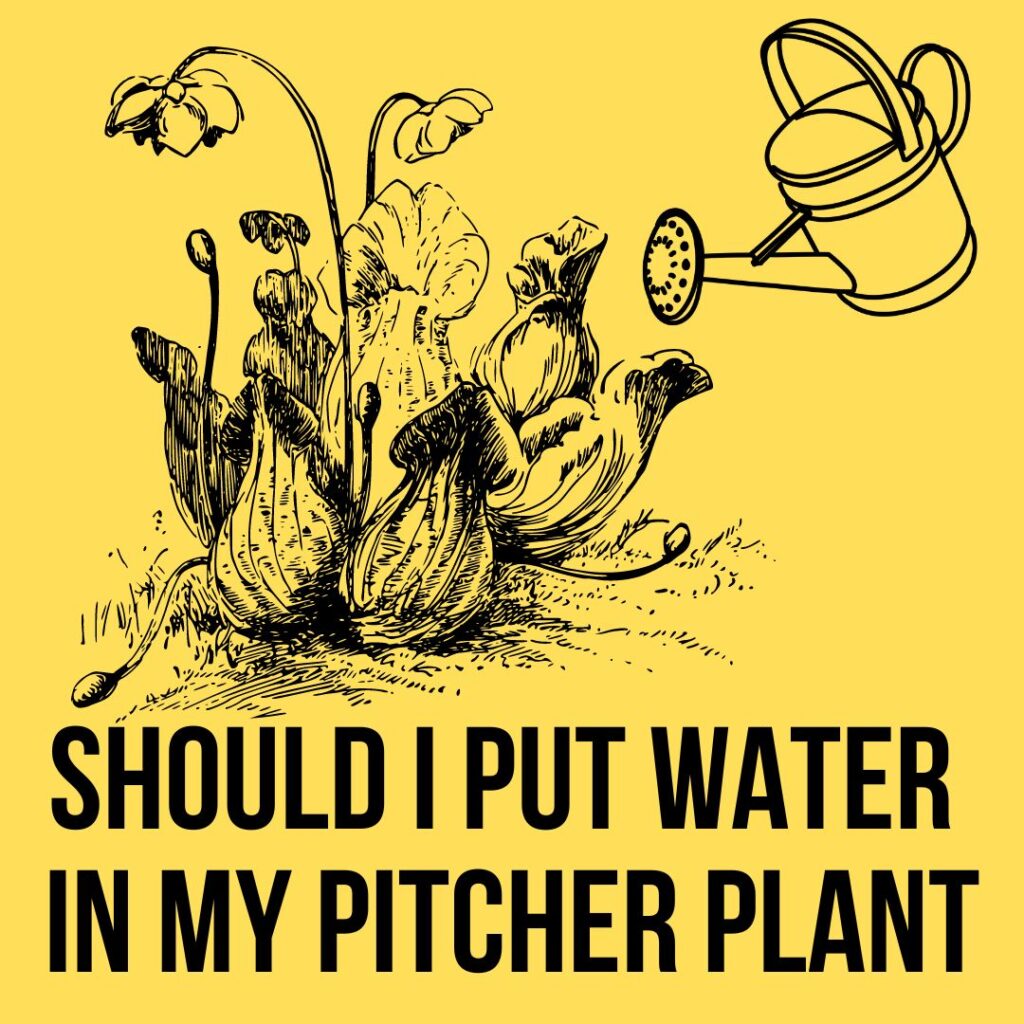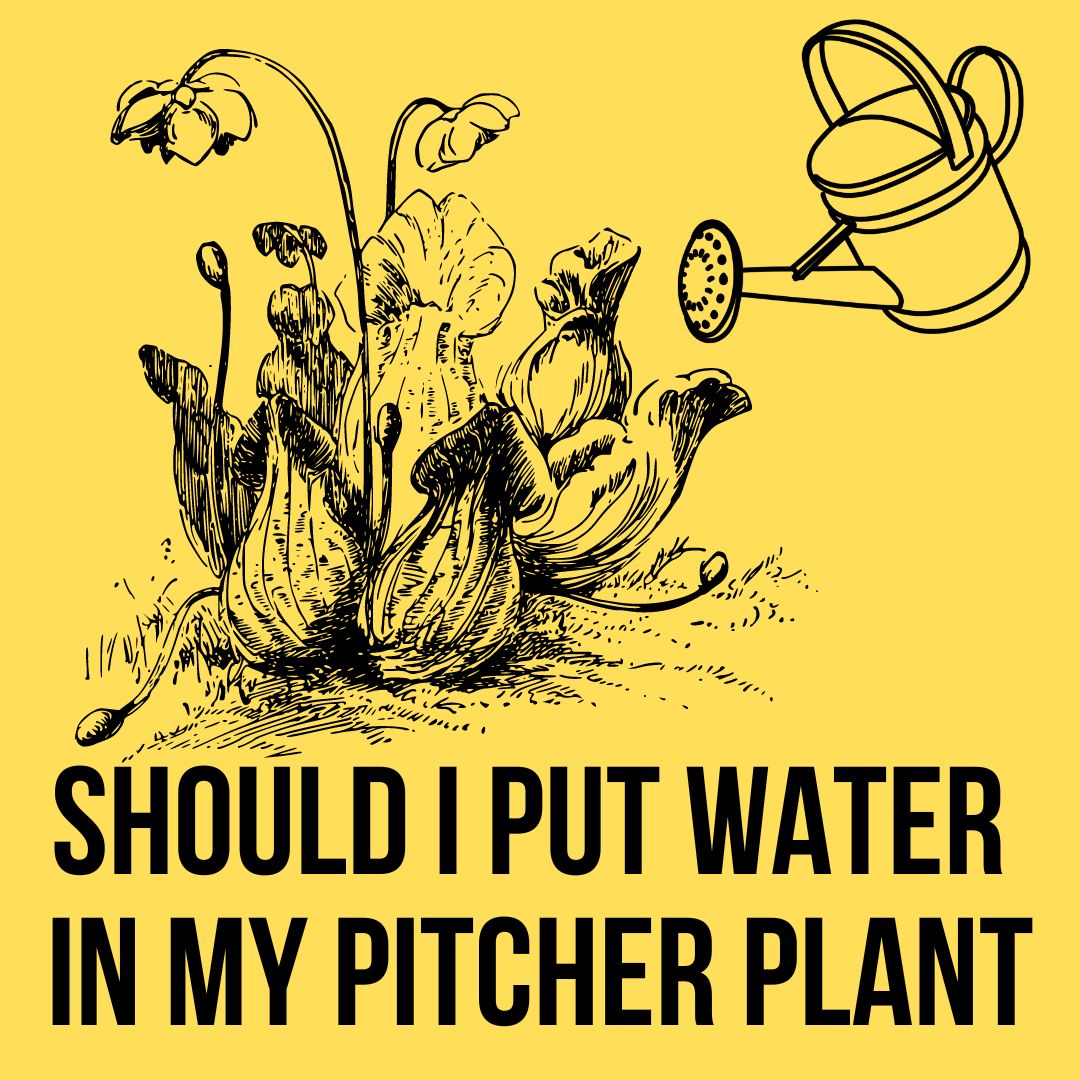Nepenthes and Sarracenia are the two most significant pitcher plants known to gardeners. Whereas nepenthes has a pretty interesting name, monkey cups. This mainly comes from the local people as it was once thought that monkeys were used to drink rainwater from its pitcher. But it’s a different thing. Some gardeners get confused and ask ‘should I put water in my pitcher plants’ since it has an idle shape and place for containing water.
So today we are going to seek an answer about it.
Should I Put Water In My Pitcher Plants?
Shortly speaking, water can be put in sarracenia only since they don’t produce their own water. For Nepenthes and pitcher plants it’s not necessary because they produce their own liquid. But if needed or for special conditions, one can put water in the pitchers.
Carnivorous plants can catch prey using their own traps which are enveloped over time. Different plants use different tools. But all of them are basically traps. Their methods are divided into mainly 5 categories. And Pitcher plant has one of them, Pitfall traps which is a rolled leaf containing a pool of digestive liquid.
Their prey falls into their traps and get digested over time. Some of them produce their own liquid, and some of them do not. So you have to be about filling water in the pitcher like when to put water, whom to put water.

Why should not put water
Without Sarracenia, other carnivorous plants produce their own liquid in the pitchers. These liquids are mainly digestive enzymes that help to devour the trapped prey slowly, also they are acidic. So if you add more water the digestive enzyme will be diluted. It will decrease the success rate of catching the prey. Slow digesting also cause overfeeding which will eventually lead to the rotting of the root faster.
Nepenthes produce their own digestive fluid. They don’t need extended pitcher water to live. You may notice that they have a hood on the top of the pitcher. This hood closes the upper face of the pitcher after catching the prey, preventing rainwater to go in them, etc. s they have hoods to protect themselves from rainwater. You can guess they don’t need extra water.
As Nepenthes produce their own digestive fluid, it’s not needed to put water in pitchers. Because it will dilute their own liquids which will eventually kill the plant.
Why should put water
Now, we are going to know why and when your pitcher plant needs water. Like Nepenthes, Sarracenia is also a vast genus of pitcher plants. Though they are totally different species. Nepenthes is a tropical plant whereas Sarracenia is a temperate plant.
Sarracenia can not produce its own liquid. It mainly drowns its prey in its liquid. Since it can not produce its own liquid it depends on rainwater. Fluid is a must for catching their prey. Sarracenia doesn’t have acidic digestive fluid like other carnivorous plants. It depends on hosting diverse organisms which mainly dissolve their prey.
Their digestion process works via bacteria. They need ¼ height of the water of the pitcher to ensure a good environment for healthy bacterial populations. Naturally, they get water from rain. But if you are growing them indoors you have to provide the needed water yourself.
When you see your Sarracenia pitchers low on water, put water in them. But do not fill the pitcher. They are not made to hold large amounts of water. They will tip over if the pitchers are filled. Fill the ¼ of the pitchers, it’s safe.
Until now we have only discussed putting water in Sarracenia but in some conditions even Nepenthes may need water. Like when the plant is shipped to you from the stores, you will notice that the pitcher is dry. It has run out of fluids. In that case, put some water in the Nepenthes. Otherwise, the pitcher will turn brown. Some research tells us that Nepenthe’s sticky viscoelastic fluid retains prey (insects) much more effectively than water. So a tiny bit of water won’t harm the plant.
Carnivorous plants should be watered with only low TDS ( Total Dissolved Solids) water. Naturally, they grow in low-nutrient soil so they can not take high amounts of nutrients. Because it overloads their system and eventually will be killed. You can buy a TDS meter from online shops to determine TDS.
Carnivorous plants can only tolerate pure water without any minerals. Use reverse osmosis water, rainwater, and distilled water.
Can I drink water from the pitcher?
This question is quite p[opular among the growers. They often think about drinking water from the pitcher. First, you have to remember that the water in the pitchers is not pure water. They are mixed with digestive enzymes and bacteria. It tastes like stomach acid. Sometimes it will taste like a dead bug mix. Easily speaking it tastes horrible.
Say you are stuck in a jungle and you have lost. Already ran out of water or anything to drink. Some survival experts suggest that you may drink water from a pitcher in only those conditions. But it’s only for emergencies.
The effectiveness of the water in the pitcher mainly depends on the species. Nepenthes has only digestive enzymes; on the other hand, Sarracenia has a mixture of bacteria with pure water. And they have a very large scale of bacteria in their fluids; some of them may cause problematic health issues.

Conclusion
The Pitcher plant is a famous sub-sector of the carnivorous plant. They need special fluid to catch the prey. These fluids are mainly digestive liquids. Some of them take help from digestive enzymes, and some of them depend on bacteria for digestive mechanisms.
Whether you should put water in the pitcher plant depends on the species. Unlike other pitcher plants, Sarracenia can not produce its own liquids. They depend on rainwater. So if they are growing indoors you have to provide water. But you must use pure water which does not contain any minerals.
Now for other pitcher plants like Nepenthes, if they are grown properly they can easily produce their own fluid. So adding excess water is not necessary. But if the fluid is dried out or the plant is newly shipped to you the pitcher may have run out of water. So, in that case, you can add some water.
